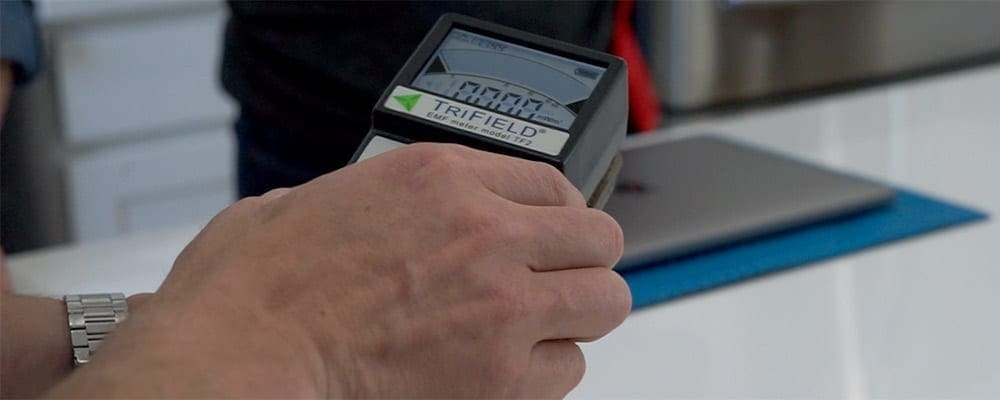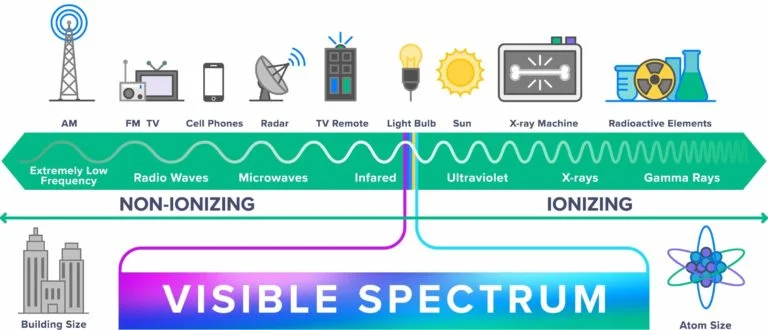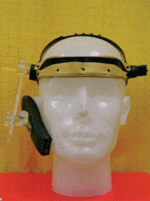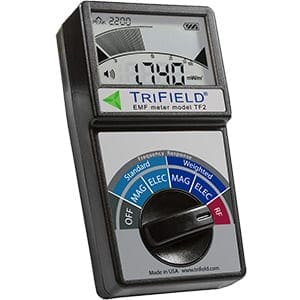EMF radiation"Radiation" in the context of Electromagnetic Fields (EMF) refers to the process by which energy is emitted and transmitted through space or a material medium in the form of electromagnetic... is harmful to your health. And the type of health problems you experience is directly linked to how much EMF you’re exposed to. But since EMF is invisible, odorless, and you can’t touch or taste it, how can you determine your exposure level? Simple —through EMF testing.
So, what is EMF testing? Well, that’s what I’m about to answer for you.
What is EMF Testing?
With the exponential growth in EMF-emitting tech, and the increased health risks that come with it, many people are asking this question.
Today, we have many wireless devices and electrical appliances in our homes. And they all emit EMF in one way or another.
So, with EMF testing, your goal is to determine how much EMF your devices are emitting, as well as how much EMF is present in your surroundings.
And to do that, you use a device called an EMF meter.

Want to Slash Your EMF Health Risks?
Want to Slash Your EMF Health Risks?
Good! Learn the one small change you should make right now.
What is an EMF Meter?
You may have heard of a Geiger counter or seen one in the movies. It’s a handheld device that detects ionizing radiation"Ionizing radiation" refers to a type of electromagnetic radiation that carries enough energy to liberate electrons from atoms or molecules, thereby ionizing them. This form of radiation is part of... like Gamma Rays and beta particles in the environment.
Gamma radiation (which gets into the environment, for example, when a nuclear power"Power" in a scientific context refers to the rate at which work is done or energy is transferred. In simpler terms, it's how fast something is using energy. For example,... plant has a meltdown) is a type of EMF. But gamma radiation has so much energy"Energy" is a fundamental concept in physics, often described as the ability to do work or cause change. In everyday terms, it's what is needed to move things, heat them... that it sits on the higher end of the electromagnetic spectrum.
This type of radiation is called ionizing radiation. It’s called that because it has so much energy it knocks electrons out of the atoms in your body. This process is called ionization.
And ionizing radiation is hazardous, even in very low doses.
The type of EMF we’re talking about here today – the kind emitted by cell phones, laptops and power lines – has much less energy. It can’t knock electrons away from atoms. Thus, it’s known as non-ionizing radiation.
But even though non-ionizing radiation doesn’t have the same effect as ionizing radiation, it doesn’t mean it’s safe.
Research studies have found that prolonged exposure to non-ionizing EMFs can cause problems ranging from minor sleep disorders to chronic diseases like cancer.
Also, just to be clear, the term “radiation” and EMFs can be used interchangeably. And you’ll see me alternate these terms a lot in this post. Just know that they mean the same thing.
So, in this post, we’re talking about testing non-ionizing EMFs. Ones that you’re exposed to daily through your electronic gadgets and electrical appliances.
What Is the Purpose of EMF Testing?
Each day, the amount of EMF in our environment increases. And the more of it you’re exposed to, the greater the risk to your health.
Learn more about EMF-induced health problems in my “Health Effects of EMF Radiation” post collection.
At the same time, EMF is an invisible force. You can’t see, touch, smell, or taste it. (The only exception is if you are electrosensitive – then you would feel it and experience allergy-like symptoms whenever you’re close to EMF sources.)
Science has made it clear that EMF is a significant health risk. But you can’t know how big of a threat the EMF levels in your home are unless you test.
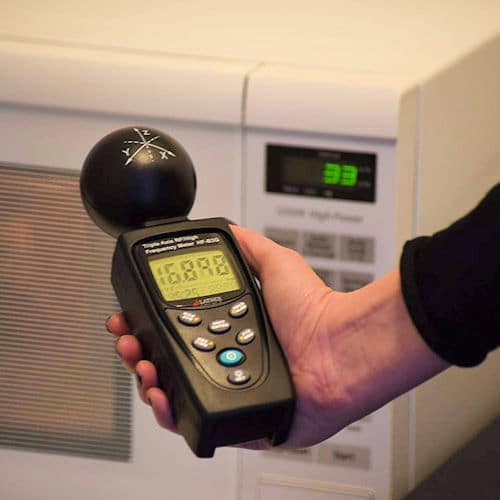
The purpose of EMF testing is simple: To see how much EMF you’re being exposed to and if those levels exceed safe limits (more on safe EMF levels later). Besides that, an EMF test will also tell you exactly where the EMF is coming from.
Testing is also really useful if you’re planning to move. If you’re buying a new house or looking for a new apartment to rent, residential EMF testing is a great way to see what the EMF levels might be at your potential new home.
Finally, learning how to test for yourself is even more critical if you want to use EMF protection products.
So, to sum up, there are two main reasons to use EMF testing.
- To get an understanding of the EMF levels you’re being exposed to. And…
- To test EMF protection products to know if they’re really working.
Are EMF Protection Products Regulated?
Unfortunately, EMF protection products are not regulated.
That leaves the industry very susceptible to misleading claims and false advertising.
Many EMF protection companies out there blatantly lie about how well their products work. Some even intentionally mislead with their testing data.
And that’s why I encourage my customers to learn how to test EMF shieldingEMF shielding refers to the practice of reducing the electromagnetic field (EMF) exposure in a particular area by blocking or altering the electromagnetic waves with barriers made of conductive or... for themselves.
Once one of my customers reviewed one of my products on Amazon. They complained that we send our customers instructions on how to test our SYB products for themselves and do not provide the testing data. Here’s what the review said.
“Why don’t you just post the test results instead of telling us how to test for ourselves?”
-An Amazon Reviewer
(Actually, we do post test results. But there isn’t a convenient or practical way to do so on Amazon. So maybe this customer didn’t see the data on our website.)
Besides that, EMF shielding manufacturers (like ourselves) publish the test results from tests done in a controlled laboratory setting. This, in most cases, doesn’t replicate real-world conditions. So, sometimes the only way to know if a product is effective is to test it under the specific circumstances you are using it.
This is why I invest a lot of effort teaching my customers how to verify that my products work the way I claim.
So, to dig in, let’s start by looking at different types of EMF tests.
The Different Types of EMF Tests
There are actually many types of EMF tests. And the kind of test you do depends on what you’re testing.
For instance, the FCC (Federal Communications Commission) requires testing wireless products to ensure they don’t interfere with other wireless devices. That’s one kind of EMF testing.
But it’s not the kind we’re talking about in this post. You may also have heard of SAR testing. SAR (or specific absorption rate) is a type of testing that tech companies must do to legally sell their devices.
This test ensures that their devices don’t emit more radiation than what’s legally allowed. (Although, as the PhoneGate scandal shows us, this testing is less than reliable.)
As the name suggests, SAR tests measure how much radiation is absorbed by something. In the case of cell phones, that something is the human body. But there are a lot of problems with this type of measurement. That’s because the amount of radiation your body absorbs depends on many variables, like weight, muscle mass, and gender.
This is why SAR tests can be so misleading and so easily distorted. And many experts feel that it’s not the best way to measure EMF.
On top of all that, SAR testing equipment is incredibly bulky and expensive. So it’s essentially impossible for you to do at home.
So, what type of EMF test are we talking about here?
EMF Emissions Tests
EMF emissions tests tell us how much EMF an object emits or sends into the environment.
By performing EMF emissions tests, for example, you can see how much EMF your cell phone or smart meter is emitting.
EMF Attenuation Tests
Another type of test we’re talking about here is called an EMF attenuation test. Attenuation tests are helpful to verify claims of products like mine that shield you against harmful EMF radiation. And they’re done in laboratories with high-grade equipment.
Attenuation essentially means blocking.
This test tells us how much EMF radiation a product like our SYB Phone Pouch will ‘attenuate’ or block.
And that’s why companies like mine publish attenuation test results of our products to show you that our products actually work.
What Do EMF Attenuation Tests Actually Tell Us?
Attenuation tests do, in fact, tell us how much EMF can a certain product block. But the data only tells us this specific product can block EMF under very specific circumstances.
Say a company claims that their product blocks 99% of EMF radiation. What they’re really saying is that it blocks up to 99% of EMF when used in a specific set of circumstances.
Those circumstances refer to things like:
- What the source of the EMF was
- The position of the shielding product in relation to the source
- And the tools used to measure the EMF levels, and so on.
Because of these changeable factors, the lab test data may not actually tell you how well the product will work in real life. The laboratory testing environment is too artificial and unrelated to how you will actually use the product.
So, when you test for yourself, you can see, first-hand, if a product is effective in the specific circumstances in which you use it.
Those are the only test results that matter for you and your health.
But before we get there, I want to discuss a few more reasons why attenuation test results can be so misleading.
Tests Can Be Very Misleading
I once designed a shielding product for SYB.
And the lab tests showed that this product blocked 99% of EMF radiation. That’s really good, right?
But when I tested the product in real life, I found out that the product shielded very little EMF. In most cases, 20% of what laboratory tests showed.
But why the difference?
Because in real life, my customers would use the product very differently from how the lab tested it.
So, I do not sell that product.
But I could sell it.
And I could truthfully say that “lab tests show it blocks up to 99% of EMF radiation.”
That would make you want to buy it.
And unless you tested for yourself, you’d never know the shielding wasn’t working right.
I’m sharing this story to demonstrate just how misleading lab test data can be.
You can’t just rely on it or assume it’s true. And you definitely can’t assume that the results will apply to how you use the product.
That’s why you need to test for yourself.
Because, as any scientist will tell you, you can design a scientific experiment to demonstrate anything.
In fact, this is precisely how the wireless industry can show concrete scientific evidences proving that EMF has no impact on human health. It’s not because they’re lying or practicing faulty science.
It’s because they design these studies from the groundIn the context of electricity, "ground" or "earthing" refers to a reference point in an electrical circuit from which voltages are measured, a common return path for electric current, or... up to show specific results, even if those results do not apply to real life.
Another way that some EMF protection companies try to mislead you is with FCC Certified Testing.
Let’s see why.
What is FCC Certified Testing?
You may have noticed that some EMF protection companies display and market “FCC Certified Testing” for their products.
So, I thought it would be helpful to explain what this means.

FCC is the United States Federal Communications Commission. This is the agency of the US federal government that regulates wireless communication.
Now, you might think that FCC-certified testing is performed by the FCC. That is incorrect.
FCC-certified testing means that a test was performed at a laboratory certified as FCC compliant.
The lab has to use specific devices and processes suitable to approve products that the FCC regulates. (If you’re interested in the details, you can check the FCC qualifications for testing laboratories.)
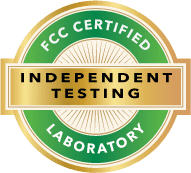
But, FCC Does NOT Regulate EMF Protection Products
Here’s the critical thing: the FCC does not regulate EMF protection products!
So, what does the FCC do? The FCC’s mission statement explains that the agency:
“regulates interstate and international communications by radio, television, wire, satellite, and cable in all 50 states, the District of Columbia, and U.S. territories.”
Notice how that mission does not even mention EMF or health effects? Yeah, me too.
The FCC barely even cares about the harmful effects of EMF radiation. In fact, the only aspect of human health FCC cares about is that the wireless device doesn’t burn you (the so-called ‘thermal effect’).
That’s it. Really.
In short, the FCC does not care about EMF health.
At all. (They are, after all, the regulatory agency that has ruled that 5G is completely safe.)
FCC-certified lab only matters if, say, you’re releasing a new electronic gadget. You’d need to prove to the FCC that it doesn’t interfere with other wireless devices. And only after this can you get the approval to release your product.
But that’s it!
Suppose you’re looking to test anything else. In that case, the fact that a test was done at an FCC-certified lab is entirely irrelevant.
FCC Guidelines Aren’t the Pinnacle of EMF Safety
So, saying that your EMF protection product was tested at an FCC-certified laboratory would be like the NFL bragging that “the Super Bowl was refereed by the absolute best Major League Baseball umpires!”
It makes no sense!
In fact, I’ve contacted several of these FCC-certified labs myself. As it turns out, many of them do not even know how to test EMF shielding products.
Why? Because:
- It’s not what they’re used to doing.
- It’s not their business.
- And there are no governmental or international bodies that regulate EMF protection products.
Companies use “FCC Certified Labs” as a stand-in authority for marketing purposes. That’s it. Just to lull their customers into a false sense of security.
Remember: what actually matters is testing for the real-world circumstances in which you will use EMF shielding products.
This is just another example of why it’s really important for you to know how to test EMF protection products for yourself.
Different Types of Non-Ionizing EMF Radiation
Before we move further and learn more about testing EMF at home, you need to be familiar with the different types of EMF.
We already discussed the difference between ionizing and non-ionizing forms of EMF radiation. But even within non-ionizing EMFs, there are different types. (Again, feel free to check out my post about the electromagnetic spectrum, which I briefly touched on earlier in this post.)
Here we’ll look at two types of non-ionizing EMF radiation, as they’re the ones we’re most exposed to.
Radio Frequency
Radio frequencyRadio Frequency (or RF), a subset of EMF, encompasses electromagnetic wave frequencies ranging from about 3 kilohertz (kHz) to 300 gigahertz (GHz). These frequencies are extensively used in modern wireless... (or RF) is a type of radiation that your wireless devices use to connect with the network source. Your cell phone, your WiFi router, your baby monitor, your favorite radio station – all of these technologies rely on RF radiation to function.
Besides your wireless devices, your microwave oven also uses RF to heat your food. The only difference is that it’s much more powerful than the radiation cell phones use, and it’s specifically called “microwave radiationMicrowave radiation is a form of electromagnetic radiation with wavelengths ranging from one meter to one millimeter; with frequencies between 300 MHz (0.3 GHz) and 300 GHz. This type of....”
Extremely Low Frequency
Extremely Low FrequencyDefinition and Characteristics Extremely Low Frequency (ELF) refers to the lower end of the electromagnetic (EM) spectrum with frequencies from 3 Hz to 300 Hz. This range lies below the... (or ELF) is the type of EMF radiation that power lines and electrical appliances emit. It’s weaker in energy than RF radiation. (But don’t confuse that with power because EMF energy and power are two different things.)
So, in short, radio frequency"Frequency" in the context of electricity, Electromagnetic Fields (EMF), and wireless communication, can be thought of as the number of times something happens in a second. Specifically, it refers to... (RF) is the kind of EMF that your wireless devices emit to communicate with the network source. And extremely low frequency (ELF) is the kind of EMF that devices on AC (alternating currentFundamentals of Alternating Current Alternating current (AC) is a type of electrical current in which the flow of electric charge periodically reverses direction. In contrast to direct current (DC) where...) power emit.
And when it comes to the tests I’m talking about in this post, both types of EMFs matter. Because both of these are emitted by modern technology.
And, to make things slightly more complicated, ELF is actually considered two separate forces— electric and magnetic. And RF is deemed to be a single electromagnetic force.
What that means for us is that we have to actually measure three types of EMFs. And they are:
- RF
- ELF-magnetic
- ELF-electric
What EMF Meter Should I Buy?
It likely won’t surprise you that all these EMF types require different meters.
Except, a bit of good news!
There’s an EMF meter called the TriField. And it’s called the TriField because it measures all three types of EMF radiation in one device. It’s also relatively affordable and reasonably accurate.
So, when customers ask me which type of EMF meter to buy, I often point them to the TriField TF2. With this meter, you can measure all three types of non-ionizing EMFs in one reasonably priced and reasonably accurate device.
Consumer-grade meters (like the TriField) are incredibly useful and could be an important part of your EMF protection arsenal.
But it is important to understand that they are limited in their accuracy. There is a reason your meter costs ~$150, but the ones in labs cost tens of thousands of dollars.
As a result, these home meters can get stuff wrong sometimes. They aren’t the most accurate or the most sensitive. And they can combine readings from different sets of frequencies. If you use different meters, you’ll often find they don’t show you the same values.
So, I advocate using a decent consumer-grade meter. I really do think they are incredibly important tools for people like you who are aware of EMF’s adverse effects. But they aren’t perfect.
Lab Measurements Vs. Home Measurements
Generally, if you have a decent consumer-grade meter, it can tell you if the level of EMF in your environment is high or low.
And when it comes to testing EMF protection products, like the ones you can buy here at SYB, a good consumer-grade meter can generally tell you if the product is actually providing you with protection – in other words, if it’s actually working to reduce your exposure.
But none of these home meters can really tell you exactly how much radiation is being shielded. They aren’t accurate enough for that.
But they are good enough to know if you’re exposed to a lot or a little EMF, and whether your EMF protection is working. That in itself is very useful information.
How do I Test EMF for Myself?
Testing EMF is actually relatively simple once you get the hang of it.
Turn on your meter. If it has multiple settings, you’ll want to ensure that it’s set to the correct setting for what you are trying to measure.
Then, hold your meter steady in the area you want to measure. For example, hold your meter up to your cell phone. Try it when your phone is on a call or streaming video. And then try it with your phone in airplane mode. You’ll be amazed at the different readings.
And that’s it!
Now you’re testing EMF for yourself!
How to Measure 5G Radiation?
Testing EMF from your 5G"5G" refers to the fifth generation of wireless communication technology, a step up from the previous 4G, 3G, and 2G networks. It's designed to provide faster internet speeds, more reliable... device is a bit different to testing emissions from 4G, 3G, or WiFi-based devices. This is because of the difference in frequencies that these EMF sources operate on.
4G operates on frequencies below 6 GHz. So, EMF meters like the Trifield TF2 can easily and accurately measure EMF from 4G sources.
But 5G is actually predicted to go up to 300 GHz. So, you won’t be able to use meters like the TF2 to measure 5G. And so far, there are no real consumer-grade EMF meters that can test 5G.
However, the good news is that we’re at the initial stages of 5G development and, as such, it has not yet reached the extreme height of its frequency allocation. So, right now, some 5G sources overlap with 4G at around 4GHz.
So, if your 5G device operates on frequencies below 10 GHz, you can, in fact, measure its EMF emissions using some of the consumer-grade EMF meters that we have today.
There is one that even goes up to 20 GHz. It’s called the FM5 RF Meter. And although it’s not as accurate as the EMF meters I recommend, it’s by far the most affordable option that measures frequencies above 10 GHz.Check out the full list of EMF meters that I recommended in my free downloadable eBook entitled“How to Test EMF For Yourself.”
How do I Test EMF Protection Products for Myself?
If you want to verify the product claims of products like my SYB Phone Pouch, take your cell phone and use your EMF meter to measure the EMF emissions.
Then put your SYB Phone Pouch between the phone and the meter and measure again.
If you see a reduction, then the EMF protection is working. The reduction in emissions shows that your SYB product actually works.
You can also check out the SYB EMF Shielding Test Videos to see how it’s done.
At-Home EMF Testing Pro Tips
It really is that simple to test EMF levels, and EMF shielding performance, for yourself. That’s all that goes into performing a basic test. But if you want better results, there are a few things to remember.
1) Cheap Meters are Cheap
I get it. EMF meters aren’t cheap. Who wants to buy a $140 or $200 or $300 meter just to test whether their $30 Phone Pouch is working?
It turns out there are a lot of very inexpensive EMF meters available. But they are inexpensive for a reason — they’re not very good.
They are not accurate and should not be used for testing.
2) Measure Background Levels
When testing, you’ll also want to measure how much ambient EMF radiation is in your testing environment. This is because your results can be very misleading if you’re testing in a high-EMF environment (such as near a WiFi router).
So, before you begin your test, take some measurements and make sure the background level of EMF isn’t too high.
For EMF product testing, you want to find a place with as low EMF levels as possible to perform your test.
3) Hold Still
Many EMF meters — especially the more affordable ones — need to be held in a consistent position for at least a few seconds to get an accurate measurement.
If you move the meter around too much, too quickly, you can get inaccurate results.
4) Don’t Touch
The human body is an EMF conductorThe term "conductor," in the context of electromagnetic radiation, refers to materials or substances that allow for the efficient passage of electromagnetic energy, including both electric currents and electromagnetic fields..... And as a result, your body can throw off the accuracy of your test results.
So, when testing, do not touch the EMF source (like the cell phone or WiFi router that you’re using as the source for your test).
If possible, also do not touch the meter — let it read out measurements without touching it. But that’s not always possible. And frankly, it’s not as important as ensuring you do not touch the device you are using as the EMF source in your test.
5) Beware ‘MAX’ Levels
All EMF meters are only designed to measure up to certain levels of EMF. The TriField TF2, for example, maxes out RF readings at 20 mW/cm2 (milliwatt per centimeter squared), and the Acousticom 2 maxes out at 6 V/m (volts per meter"Volts per meter" (V/m) is a unit of measurement in the International System of Units (SI) that quantifies the strength of an electric field. This unit is particularly relevant in...).
When your meter indicates a max reading, that means it is measuring at least that level of radiation. The actual level could be much higher.
In other words, when your meter is at the max, you don’t actually know what the measured level of radiation is. And if you don’t know what the actual level of EMF is, you can’t know how much is being shielded.
6) Check Levels, Not Lights
Several EMF meters, including the Acousticom 2 and the Cornet RF meters, include a column of lights designed to indicate risk.
While these lights are helpful, they do not, on their own, indicate shielding effectiveness. For example, on Acousticom 2, a reading of 6 V/m is red, and a reading of 0.1 V/m is still yellow (not green). 0.1 V/m is a 98.3% reduction in fieldIn the context of electromagnetic fields (EMF), the term "field" refers to a region in space where electric and magnetic forces are exerted. An electromagnetic field is generated by electrically... strength from 6 V/m, but if you just rely on the lights, you won’t see how much radiation is being shielded.
So, always check the actual levels — don’t rely on the lights.
7) Be Aware of Logarithmic Displays
Many EMF meters use logarithmic displays, including the TriField 100XE (the predecessor of the TF2) and the Acousticom 2. This means the readouts aren’t linear.
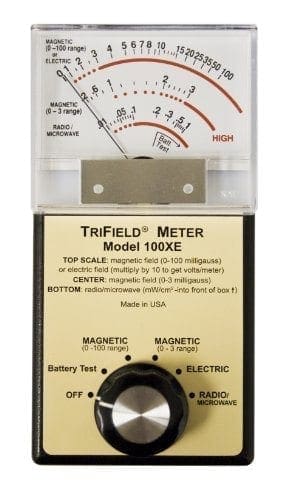
For example, on the TriField 100XE, the max level (if the needle is all the way to the right) is 1 mW/cm2. If the needle is only halfway on the scale (pointed straight up), the level is actually approximately 0.18 mW/cm2. Because the needle is halfway to the max, you might think that the measured level is half of the max. But in reality, it’s 18% of the max (so, way less than 50%).
In this way, logarithmic displays can be really counter-intuitive – not inaccurate, but a bit misleading. So, when you’re using a meter with logarithmic displays, make sure to properly check the actual levels measured.
8) Direction Matters
EMF is a force that has direction. So, the direction of your meter in relation to the direction of the EMF you are measuring will influence your results.
The TriField, like all the EMF meters I generally recommend (mentioned in my free eBook), are single-axis meters. This means they are designed to measure EMF along a single axis in a single direction.
In order to account for that, you should take measurements of the same area, with your meter pointed in different directions. It’s pretty likely that the levels you measure will change.
I tend to recommend single-axis meters to my customers because those are the most affordable options. But if you want increased accuracy, invest in a triple-axis RF meter, like the TES 593. Then you do not need to worry about moving your meter in different directions to get the increased accuracy.
What is the Unit for EMF?
Each of the three types of EMF that we’re measuring are measured using different units.
ELF-magnetic fields are measured using a unit called a gauss (G), which measures magnetic flux density"Magnetic Flux Density" is a fundamental concept in physics and electromagnetism, playing a crucial role in our understanding of waves, Electromagnetic Fields (EMF), frequency, and energy. The term is deeply.... The unit is named after the mathematician and physicist, Carl Friedrich Gauss. Most ELF-magnetic meters measure in gaussThe "gauss" is a unit of measurement used to quantify the strength of a magnetic field. Named after the German mathematician and physicist Carl Friedrich Gauss, it helps in understanding..., which is why they are often called gauss meters. But ELF-magnetic fields are also sometimes measured using units called tesla (t), named after the famous inventor (and Edison nemesis) Nikola Tesla.
Gauss and teslaThe "tesla" is a unit of measurement in the International System of Units (SI) used to quantify the strength of a magnetic field. Named after the inventor and electrical engineer... are directly convertible units. 1 tesla = 10,000 gauss (or 10 mG, milligauss).
The strength of ELF-electric fields are measured in volts per meter (V/m), which is a measure of electric potential over distance.
Different meters measure radio frequency fields with different units. All of them are measurements of power density"Power density" is a key concept in the fields of physics and engineering, referring to the amount of power (time rate of energy transfer) per unit volume. In more practical..., or how much power is present in a given area. The power is often measured in watts (just like a light bulb), and the power density is often measured in watts per square meter (W/m2), or watts per square centimeter (W/cm2).
All of these units follow the metric system. So 1,000 watts, for example, is a kilowatt (kW). And one thousandth of a WattThe "watt" is a unit of power in the International System of Units (SI) that plays a vital role in various scientific and technical domains, including the study of waves,... is a milliwatt (mW).
It’s not really important to understand all these units – after all, this is complex science – but it is important to know what units you are measuring in, so you can, for example, compare your measurements to other measurements of the same type, or to published safety limits.
What is a Normal EMF Reading?
Ah, now that’s the real question, isn’t it? What is a normal reading of EMF?
Well, it depends on what you mean by ‘normal’ or ‘safe.’ Almost all of the EMF we’re exposed to in daily life is human-made and did not exist until recently in human history. So, from that perspective, no amount of EMF is ‘normal.’
But when people ask this question, I find they are really asking, what amount of EMF is safe? And I have a separate post that attempts to answer that question for you, including the recommended safety levels from the World Health Organization and countries worldwide.
What You’ve Learned
In this post, we covered a lot of ground. We discussed:
- What EMF testing is
- What an EMF meter is and how to use one
- The difference between ionizing and non-ionizing EMF radiation
- The lack of regulation around EMF protection products
- Different types of EMF tests
- The difference between EMF absorption tests (like SAR) and EMF emissions tests
- What EMF emissions tests actually tell us
- How EMF emissions tests can be ‘sculpted’ and misused to provide you with a false sense of security
- The different types of EMF meters you might want to buy
- Which EMF meter I most commonly recommend
- How to actually test for yourself
- Tips to improve the accuracy of your testing
- What units are used for EMF testing
Final Thoughts
The increasing level of EMF in our environment is a serious problem. And it’s important for you, on the receiving end of that EMF pollution, to take preventive actions before EMF pollution can hurt you and your loved ones. These actions include testing EMFs, using EMF protection products, and changing your lifestyle to make modern technology something that works to make your life better and not worse.
And when you start doing these things, consider one part of the problem solved.
I’m saying this because EMF isn’t the only risk that comes along with modern technology.
Experts say that prolonged tech use can harm you physically, mentally, psychologically, and emotionally. Check out my “Healthier Tech” post collection for more information.
Also, check out The Healthier Tech Podcast by SYB, which has an amazing panel of experts who share tips and tricks on making your tech use a safer, healthier experience. We’re available on all major platforms.
